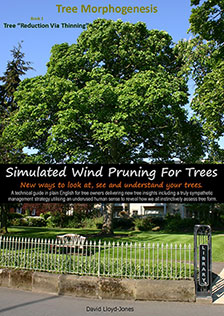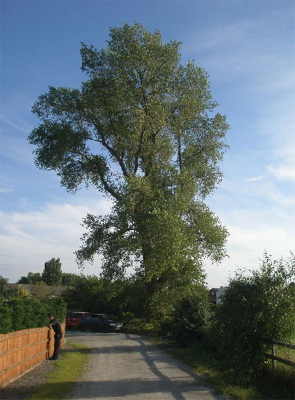
Tree Morphogenesis
 I found David Lloyd-Jones Tree Morphogenesis Book 1 Reduction Via Thinning
as an Amazon freebie, and was soon drawn into the book despite (or
perhaps because of) its density. The author has spent the last 28
years as an arborist, pruning huge trees in a city setting in
London. In the process, he developed his own theories about how
trees grow and how we can prune them in ways that promote their natural
growth rather than hinder it.
I found David Lloyd-Jones Tree Morphogenesis Book 1 Reduction Via Thinning
as an Amazon freebie, and was soon drawn into the book despite (or
perhaps because of) its density. The author has spent the last 28
years as an arborist, pruning huge trees in a city setting in
London. In the process, he developed his own theories about how
trees grow and how we can prune them in ways that promote their natural
growth rather than hinder it.
The author's thesis is
that the shape of wild trees is determined by what he calls growth phase
shifts. What's that? Well, imagine a young tree: due to
apical dominance (the highest bud suppressing everyone else's growth),
young trees tend to shoot straight up if left alone. At a certain
point, though, something damages that apical bud --- maybe wind, a
spring frost, or a midsummer drought. This is the growth phase
shift, when side buds get a chance to grow for a short while, until a
new apical bud takes over. Each growth phase shift results in a
complication in the tree's growth form, whether that means a double
trunk or simply a larger branch that is able to compete with the central
leader for a short time.
 From
an arborist's point of view, growth phase shifts are important because
they tend to create acutely-angled branch forks when two branches
compete for the role of central leader. In contrast, when a tree
is growing straight up, branches tend to come off at a more shallow
angle since the upward growth of side branches is being suppressed by
the central bud. As orchardists know, acute branch forks are
weaker, and Lloyd-Jones goes through a long and fascinating hypothetical
account of how evolution may have favored these acute branch angles
because those branches snap off during heavy winds rather than taking
down the whole tree.
From
an arborist's point of view, growth phase shifts are important because
they tend to create acutely-angled branch forks when two branches
compete for the role of central leader. In contrast, when a tree
is growing straight up, branches tend to come off at a more shallow
angle since the upward growth of side branches is being suppressed by
the central bud. As orchardists know, acute branch forks are
weaker, and Lloyd-Jones goes through a long and fascinating hypothetical
account of how evolution may have favored these acute branch angles
because those branches snap off during heavy winds rather than taking
down the whole tree.
While most of you, like
me, probably aren't planning on becoming
arborists any time soon, homesteaders spend a lot of time thinking about
trees,
whether that's fruit trees, trees you're harvesting for firewood, or a
woodlot you're managing to create prime lumber. And even though
Lloyd-Jones doesn't speak to those topics specifically, understanding
how trees grow will help us all do a better job managing those working
trees on our homestead. Since the price is only $2.99 even if you
don't catch the book on sale, you don't have much to lose from giving it
a shot.
Want more in-depth information? Browse through our books.
Or explore more posts by date or by subject.
About us: Anna Hess and Mark Hamilton spent over a decade living self-sufficiently in the mountains of Virginia before moving north to start over from scratch in the foothills of Ohio. They've experimented with permaculture, no-till gardening, trailersteading, home-based microbusinesses and much more, writing about their adventures in both blogs and books.
Want to be notified when new comments are posted on this page? Click on the RSS button after you add a comment to subscribe to the comment feed, or simply check the box beside "email replies to me" while writing your comment.

Hi Thank you for the review of my book, much appreciated. If the reviewer was also the person who left a review on Amazon (also mentioning fruit trees), double thank you and yes I do plan to do a fruit tree supplement for restoration of unsympathetically pruned trees as well as my own tried and tested way to manage fruit trees throughout their life. In line with my book my methods are to study the life strategies of the tree and then use them subtly to train the tree and all done with secoteurs. Sorry if any of you missed the free and discounted downloads. We will be having more of both in the near future but I was travelling in West Africa (tropical tree research, some of which will find its way into book 2). Now back we intend to have a free download for the tree owners of Cheshire and surroundings so if you connect with me on Linkedin or on the website, I will let you know when that will be. Again, thank you all for the comments.
I would like to invite you to grab a copy of the Kindle version for free this Friday.
This offer is part of the pre-launch offer for the first edition of the large format printed version.
If you have any doubts as to the value and usefulness of the information in this book, read the Amazon reviews.
I want to help people to see trees with understanding and this book is designed to deliver that new understanding so please, grab yourself a copy but far more important than that, please do read it.
Thanks, David Lloyd-Jones